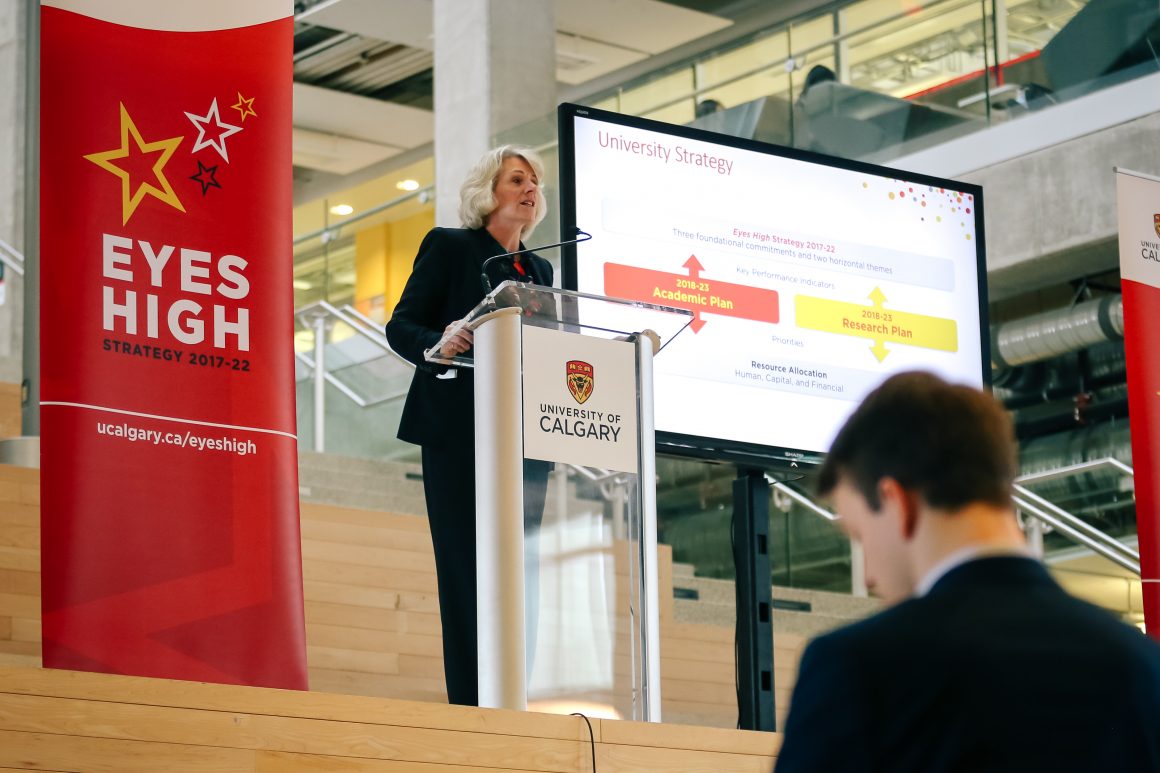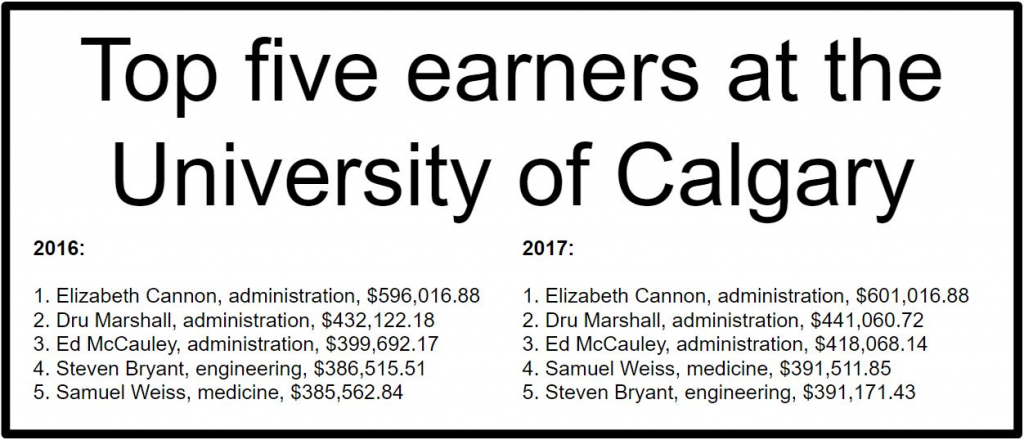
Elizabeth Cannon still top earner at U of C as Alberta releases compensation data
By Matty Hume, July 10 2018 —
The Government of Alberta has released the 2017 data for its public sector body compensation disclosure, which discloses “compensation data for employees of government agencies, boards and commissions that exceed the threshold amount during a disclosure period; as well as board members and appointees, regardless of threshold.”
This will be the last disclosure that does not reflect the Alberta New Democratic Party’s new regulations for post-secondary executives’ salaries, which came into effect on April 15 for new and renewing contracts.
The disclosure highlights individuals in the public sector who have earned over $127,765, which is the threshold for the disclosure period of Jan. 1 – Dec. 31, 2017. The threshold was set at $100,000 in 2012, and has been tied to increase with the Alberta Consumer Price Index since 2014.
This includes Alberta post-secondary institutions, such as the University of Calgary, which are required to disclose staff compensation under the provincial government’s Public Sector Compensation Transparency Act.
“The University of Calgary is committed to transparency and has complied with provincial legislation to disclose compensation for employees receiving $127,765 or more as outlined in the Public Sector Compensation Transparency Act,” read an email statement from the U of C. “UCalgary has a rigorous process for determining compensation for academics and administrative staff based on their role; the market for their skills; their education, knowledge and experience; and their overall performance in their role.”
Not including those who passed the threshold due to severance payments, there are 1,024 U of C employees who earned more than $127,765 in 2017. The university’s top five earners have remained the same.
Elizabeth Cannon remains highest paid U of C employee

Last year was the first year in which Cannon was reported as the U of C’s highest earner. She remains at the top of the list in 2017, with her cash earnings rising from $596,016.88 to $601,016.88. The rest of the top five earners saw similar increases, with Cumming School of Medicine professor Samuel Weiss now earning slightly more than Schulich School of Engineering professor Steven Bryant.
The provincial government’s disclosure does not include non-cash benefits, though they are outlined in the U of C’s own consolidated financial statement, which reports on a period from April 1, 2017 – March 31, 2018. Cannon received $297,000 in non-cash benefits in 2017, bringing her total earnings to $898,000, a slight increase from $897,000 in 2016. Provost and vice-president academic Dru Marshall saw a larger increase, with $135,000 in non-cash benefits in 2017 bringing her total earnings to $576,000, up from $569,000 in 2016.
According to the consolidated financial statement, non-cash benefits include, “the University’s share of all employee benefits and contributions or payments made on behalf of employees including pension, group life insurance, employee family assistance program, critical illness, supplementary health care, short and long-term disability plans, dental plan, professional memberships, supplemental retirement plan, accidental disability and dismemberment.”
Cannon’s benefits include a vehicle allowance and “future administrative leave benefits,” according to the U of C’s consolidated financials.
Slight decline in number of U of C employees earning above the threshold
In 2017, 1,024 U of C employees earned above the threshold, a small decline from 1,042 in 2016, staying at approximately 20 per cent of full-time employees. With the exception of the Northern Alberta Institute of Technology (NAIT), which saw an increase to 124 employees above the threshold in 2017 compared to 112 in 2016, other Alberta post-secondary institutions presented a similar trend. For example, the University of Alberta had 1,632 earn above the threshold in 2017, compared to 1,696 in 2016.
The highest earner at Grant MacEwan University was its former vice-president of finance and administration, Brent Quinton, who received a severance payment of $540,000 when he left the position in Sept. 2017. His departure came less than a month after MacEwan revealed it lost $11.8 million to a phishing scam, as reported by the Edmonton Journal.
Gender gap widens
Out of the top 100 earners at the U of C in 2017, only 20 were women. This is a decline from 21 in 2016 and 22 in 2015. Within the top 100, university administration has the highest percentage of women, at approximately 53 per cent.
Of the 26 individuals in the Cumming School of Medicine — the highest earning faculty within the top 100 — approximately 92 per cent are male.
Business surpasses administration
While medicine remains on top, business has surpassed university administration as the second-highest earning faculty at the U of C. Out of the top 100 earners, business now contains 18 individuals to administration’s 15 in 2017, compared to 18 and 19, respectively, in 2016.
The inaugural- and current-director of the Hotchkiss Brain Institute, Samuel Weiss, continues to be the highest paid employee in medicine, with a total compensation of $424,961.98 in 2017. At the Haskayne School of Business, professor and Suncor Chair in Strategy and Sustainability Harrie Vredenburg is the highest earner, with a total compensation of $360,213.61 in 2017.
View the Government of Alberta’s public sector body compensation disclosure here and the U of C’s consolidated financial statement here.
